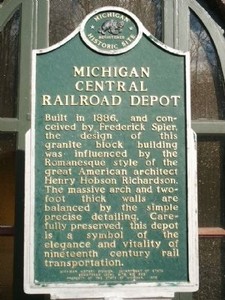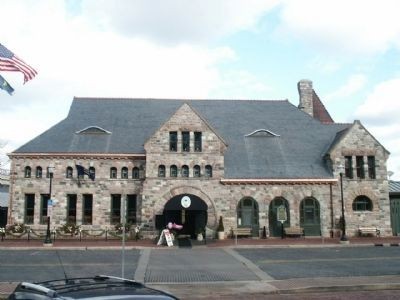Gandy Dancer and the Michigan Central Railroad Depot and Historical Marker
Introduction
Text-to-speech Audio
Images
Michigan Central Railroad Depot Historical Marker

Image of the Gandy Dancer Restaurant, formerly Michigan Central Railroad depot, and historical marker

Backstory and Context
Text-to-speech Audio
In 1832, the Detroit & St. Joseph Railroad was chartered to be the first railroad to cross Michigan, though its name was later changed to the Michigan Central Railroad. Westward construction of the railroad began in 1836, reached Ann Arbor in 1839, and Jackson in 1841. The Michigan Central Railroad was the first railroad company to cross the state when it built a railroad line to New Buffalo in 1949. This, however, was not the only first for the company. The Michigan Central Railroad company was also the first company in the nation who used the telegraph to control train operations.
The Michigan Central Railroad Depot was built in 1886 by Frederick Spier for the Michigan Central Railroad. The inspiration of the building, which is made of granite blocks, came from American architect Henry Hobson Richardson's Romanesque style and was an impressive structure.
The inside was elegant, with stained-glass windows, red oak ceilings and trim, and French tile floors, and even separate waiting areas for men and women. Ivy grew up the side of the building, petunias and carnations were planted around it, and a fountain spurted at the point of a triangular garden just east of the baggage shed, where the Gandy Dancer's valet parking lot is now. In the 1880's, gardens were considered an important element in railroad station design--after all, the station was the first impression visitors received of the town.3
The visitors that the Michigan Central Railroad Depot saw were not always everyday people. In 1960, John Kennedy and Richard Nixon addressed rallies from campaign trains and made stops in Ann Arbor. Kennedy and Nixon were not the only famous faces, though. William Howard Taft, Theodore Roosevelt, Grover Cleveland, and William Jennings Bryan also passed through the depot.
The railroad depot was sold to Chuck Muer, who opened the Gandy Dancer restaurant in the location, in 1970. The railroad company thought that passenger service was dwindling. Muer kept the railroad depot intact. He added a kitchen for the restaurant, added windows, and changed the color of trim outside.
Sources
1 Seewald, Joel. Michigan Central Railroad Depot, The Historical Marker Database. January 19th 2012. Accessed December 27th 2019. https://www.hmdb.org/m.asp?m=51751.
2 The Michigan Department of Transportation. Michigan's Railroad History, Michigan.gov. October 13th 2014. Accessed December 27th 2019. https://www.michigan.gov/documents/mdot/Michigan_Railroad_History_506899_7.pdf.
3 Farley, Ren. Ann Arbor Depot, Michigan Central Railroad Station, Detroit1701. May 1st 2010. Accessed December 27th 2019. http://www.detroit1701.org/Ann%20Arbor%20Depot,%20MCR.html.
Shackman, Grace. The Michigan Central Depot, Ann Arbor District Library. Accessed December 27th 2019. https://aadl.org/aaobserver/15258.
Courtesy of Joel Seewald at HMDB.org
Courtesy of Joel Seewald at HMDB.org
